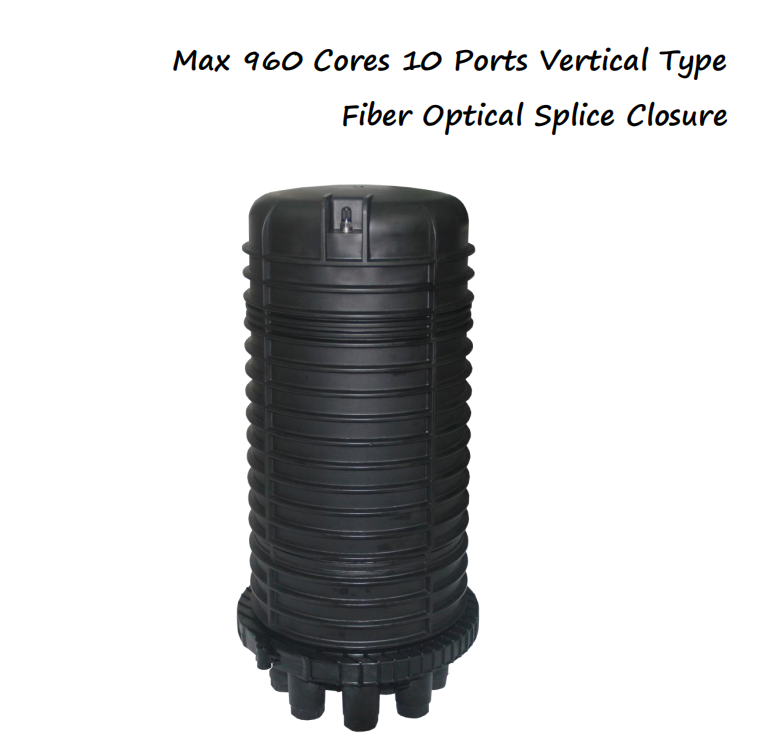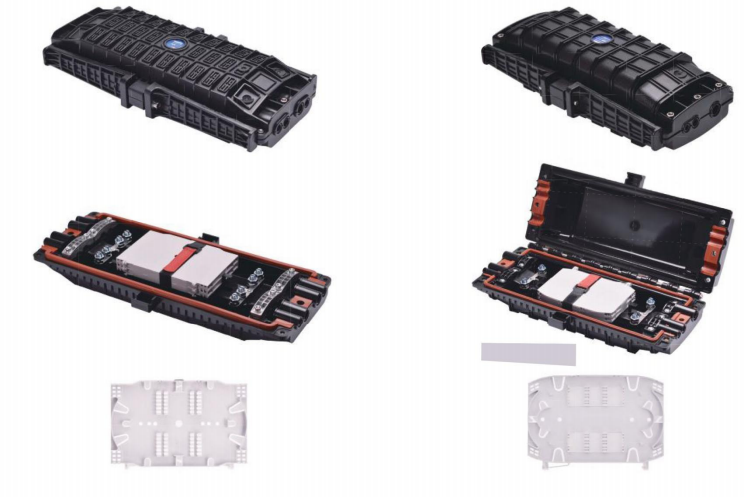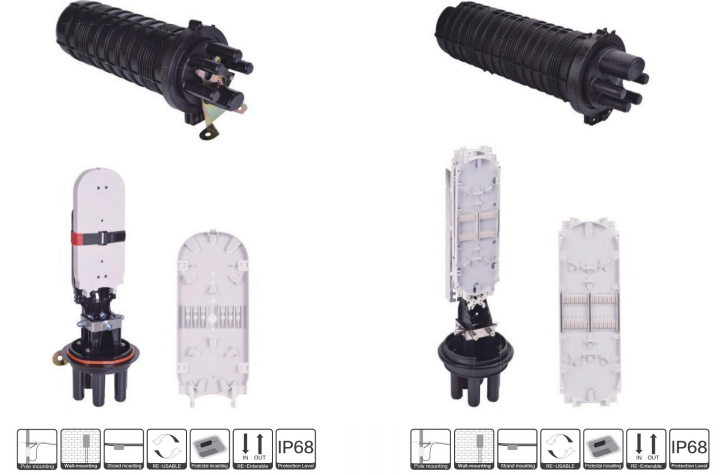Weatherproof Optic Splice Closures for Outdoor Installations

The Importance of Weatherproof Optic Splice Closures for Outdoor Installations
Fiber optic connections play a crucial role in modern telecommunications, providing high-speed data transmission and internet connectivity. However, when it comes to outdoor installations, these connections face numerous challenges. Exposure to harsh weather conditions and the risk of moisture and water damage can significantly impact their performance and reliability. This is where weatherproof optic splice closures come into play. By using waterproof and weathertight closures, network technicians can protect fiber optic connections from water ingress and moisture-related issues. This ensures the maintenance of signal integrity, minimizing signal loss, and ultimately leads to reliable and durable fiber optic networks for FTTX installations. In the following sections, we will delve deeper into the challenges faced by outdoor environments, the benefits of using waterproof closures, and how they contribute to meeting the demands of FTTX networks.
Protecting Fiber Optic Connections in Outdoor Environments
Understanding the Challenges of Outdoor Environments
Outdoor environments pose unique challenges for fiber optic connections. One of the primary concerns is exposure to harsh weather conditions. Whether it's scorching heat, freezing cold, heavy rain, or strong winds, these elements can take a toll on the delicate components of fiber optic cables and compromise their performance.
Moisture and water damage are also significant risks in outdoor installations. Rainwater, snowmelt, or even high humidity levels can seep into unprotected fiber optic connections, leading to signal loss, degradation, or complete failure. Moisture-related issues not only disrupt network connectivity but also increase the chances of corrosion and other long-term damage.
Importance of Weatherproof Optic Splice Closures
To address these challenges effectively, weatherproof optic splice closures are essential. These closures are specifically designed to prevent water ingress and protect fiber optic connections from moisture-related issues. By creating a tight seal around the spliced fibers and cable entry points, they act as a barrier against external elements.
Weatherproof closures play a crucial role in maintaining signal integrity by minimizing signal loss caused by water intrusion. They ensure that the transmitted data remains clear and reliable throughout the entire network. Additionally, these closures help extend the lifespan of fiber optic connections by shielding them from environmental factors such as dust, dirt, UV radiation, and temperature fluctuations.
By investing in weatherproof optic splice closures for outdoor installations, network technicians can significantly enhance the durability and reliability of their fiber optic networks. In the next section, we will explore the specific benefits that waterproof and weathertight closures offer in terms of protection and longevity.

Benefits of Using Waterproof and Weathertight Closures
Enhanced Protection and Longevity
One of the significant benefits of using waterproof and weathertight closures for fiber optic connections in outdoor environments is the enhanced protection they provide. These closures are designed to resist water, dust, and other environmental factors that can potentially damage the delicate components of fiber optic cables. By creating a secure barrier against external elements, they ensure the longevity and reliability of the network.
Waterproof and weathertight closures offer extended lifespan for fiber optic connections. By preventing water ingress and moisture-related issues, these closures minimize the risk of signal loss or degradation caused by corrosion or other forms of damage. This leads to improved performance and reduces the need for frequent repairs or replacements.
Ease of Installation and Maintenance
Another advantage of using waterproof and weathertight closures is their ease of installation. These closures typically feature user-friendly designs that simplify the installation process. Network technicians can quickly and efficiently secure the fiber optic cables within the closure, ensuring a proper seal to protect against water ingress.
In addition to easy installation, these closures also provide convenient access for maintenance and repairs. When necessary, technicians can easily open the closure without disrupting the entire network infrastructure. This accessibility allows for efficient troubleshooting, upgrades, or modifications without causing extensive downtime or disruption to network services.
By utilizing waterproof and weathertight closures, network technicians can enjoy enhanced protection for their fiber optic connections while benefiting from simplified installation processes and streamlined maintenance procedures. In the following sections, we will explore how these closures contribute to ensuring reliable and durable fiber optic networks specifically tailored for FTTX installations.

Ensuring Reliable and Durable Fiber Optic Networks for FTTX Installations
Meeting the Demands of FTTX Networks
FTTX (Fiber to the X) networks, including FTTH (Fiber to the Home), FTTP (Fiber to the Premises), and FTTB (Fiber to the Building), are becoming increasingly popular due to the growing demand for high-speed internet and data transmission. These networks provide faster and more reliable connectivity, enabling seamless communication, online streaming, gaming, and other bandwidth-intensive applications.
To meet the demands of FTTX networks, it is crucial to have reliable fiber optic networks in place. Optic splice closures play a vital role in ensuring network reliability by protecting fiber optic connections from environmental factors that can cause signal loss or interruptions. By using weatherproof closures specifically designed for outdoor installations, network technicians can safeguard these connections against water ingress, moisture-related issues, dust, and other potential sources of damage.
Choosing the Right Optic Splice Closure
When selecting an optic splice closure for outdoor installations in FTTX networks, there are several considerations to keep in mind. Firstly, compatibility with different fiber optic cable types is essential. The closure should be compatible with both single-mode and multi-mode fibers commonly used in FTTX deployments.
Additionally, outdoor installations require closures that can withstand various environmental conditions. Factors such as temperature extremes, UV radiation exposure, humidity levels, and physical stress need to be taken into account when choosing a closure. It's important to select a closure that meets industry standards for waterproofing and weathertightness.
By carefully considering these factors and choosing the right optic splice closure for outdoor FTTX installations, network technicians can ensure reliable and durable fiber optic networks that meet the demands of high-speed data transmission.
Conclusion: Reliable Fiber Optic Networks with Weatherproof Optic Splice Closures
In outdoor installations, protecting fiber optic connections is paramount to ensure reliable and durable networks. Weatherproof optic splice closures play a crucial role in safeguarding these connections from harsh weather conditions, moisture, and other environmental factors. By using waterproof and weathertight closures, network technicians can prevent water ingress, maintain signal integrity, and extend the lifespan of fiber optic connections. The benefits of these closures include enhanced protection, longevity, ease of installation, and maintenance. For successful FTTX installations that meet the increasing demands for high-speed internet and data transmission, choosing the right optic splice closure compatible with different fiber optic cable types is essential. Invest in weatherproof optic splice closures to enhance the reliability of your fiber optic networks in outdoor environments.
See Also
Advantages of ADSS Fiber Optic Cables for Aerial Power Lines
The Importance of Fiber Optic Cables in Subterranean Setups
The Strength of ADSS Fiber Optic Termination Kits in Network Cabling
The Advantages of Weatherproof FastConnect Fiber Field Assembly Connector
Long-lasting and Trustworthy 2 in 1 Harden Optical Connector Cable Assemblies


